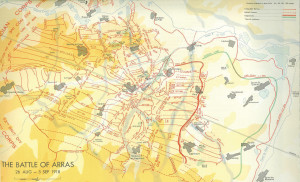
Canadians making practice attack with Tanks. Advance East of Arras. October, 1918.Canada. Dept. of National Defence/Library and Archives Canada/ PA-003257

The Hindenburg Line was a solid network of defenses, machine gun pits, and concrete redoubts. Despite the name, it was not a line at all, but rather a 30 kilometre deep belt of defenses based on British and German trenches left over from the Battle of the Somme in 1916. The Canadian Corps was called upon to break the line at Arras.
The Canadians did not get their customary rest period after the hard-fought battle at Amiens, and resented being sent into heavy combat so quickly. Nevertheless, the staff officers of the Canadian Corps got to work preparing the attack. There was no hiding where the Canadians needed to attack, so Arthur Currie opted for an unconventional night assault on August 26.
Taking the fight forward with bomb and bayonet, the Canadians made their first objectives by 5:25 AM. By the end of the day the Canadians had taken a good bite out of the German line.
From August 27 to September 1 there was a series of mini ‘set-piece’ battles, advancing eight kilometres. The four days of hard fighting, however, had just been the prologue for the attack on the Drocourt-Queant line.
The Drocourt-Queant line made up the northern portion of the Hindenburg Line and was a fortress of concrete bunkers, barbed wire, and machine guns. With almost no time to prepare, the Canadian Corps attacked the line with tanks, artillery, and tactical airpower in support. The Canadians smashed through the Drocourt-Queant line. Because of the lack of time to prepare, this victory relied more on surprise, grit and small-unit tactics than grand plans. The cost was high. For the ten kilometres the Canadian Corps gained, they lost over 10,000 men, killed or wounded. The Hindenburg Line was broken, however, and for the first time it looked as though the war could end in 1918.
After the battle former Canadian Corps commander Julian Byng cabled Arthur Currie telling him that the Canadian Corps’ smashing of the Drocourt-Queant line was the ‘turning point of the campaign.’ The most feared German defensive obstacle had been smashed, leaving open the door for one of the greatest victories in Canadian history, the Battle of the Canal du Nord.

Click the map to view it larger.
Currie, Robert
Hill, John Harrison
Kippling, George
Lacasse, Oscar
Lang, Walter William
Lusk, Andrew Gibson
Mills, Godfrey
Morton, Louis Milton
Pickett, Lewis Sherwood
Phillips, James Edgerton
Schwitzer, Rupert William
Selman, Harry

Born and raised in Glasgow, Scotland, Robert lost both of his parents by the time he was sixteen. He immigrated to Canada with his older sister and settled in Keewatin where he worked for the CPR. He enlisted in March 1916 and served overseas with the 16th Battalion (Canadian Scottish).
Robert was awarded the Military Medal for his bravery and initiative during a successful trench raid in February 1918. In August he was promoted to Corporal, but died two weeks later during the assault on the Drocourt-Quéant Line, ‘killed by fire from an enemy machine gun nest, about halfway to the objective.’
Robert Currie is commemorated on the Cenotaph in Kenora and on the Glasgow Roll of Honour.

Enlisting in June of 1915 with good friend Harold Hilliard, Harry went overseas with the 101st Battalion, later transferring to the 16th Battalion. He and his brother Monty had been active in the local sports scene in Kenora.
Serving in the front line during the Battle for Hill 70, Harry suffered a gunshot wound to the leg and was evacuated to England. Due to the wounding and other illnesses, it was August of 1918 before Harry returned to France.
Less than a week after joining the 78th Battalion in the field, while marching with the battalion, Harry was ‘instantly killed when in the vicinity of Beaufort Woods, by a bomb dropped from hostile aircraft.’ Just days earlier friend Harold was reported as killed in action.
Harry Stuart MacKenzie is buried in the Hillside British Cemetery, Moreuil, France.